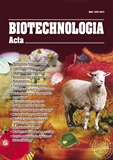ISSN 2410-7751 (Print)
ISSN 2410-776X (Online)

Biotechnologia Acta Т. 17, No. 2 , 2024
P. 46-48, Bibliography 5, Engl.
UDC::582.663:547.56:615.322
DOI: https://doi.org/10.15407/biotech17.02.046
AMARANTHUS AS A SOURCE OF POLYPHENOLIC COMPOUNDS AND FLAVONOIDS FOR USE IN MEDICINE
K.I. Hutsko, R.O.Petrina
Lviv Polytechnic National University, Ukraine
Amaranth is used as a medicinal plant with antioxidant, hemostatic, and wound-healing properties.
The aim of the research is the quantitative determination of polyphenolic compounds and flavonoids in ethanolic extracts of amaranth seeds of the "Lera" and "Ultra" varieties and leaves Amaranthus retroflexus.
Methods. Extracts were obtained by infusion for 7 days in 70% and 80% ethanol. Quantitative determination of secondary metabolites was conducted by spectrophotometric methods.
Results. The largest amount of polyphenolic compounds was found in the ethanolic extract of Amaranthus retroflexus leaves - 0.228 mg/ml. More polyphenols were found in the ethanolic extract of amaranth seeds of the "Lera" variety than in the extract of amaranth seeds of the "Ultra" variety. In the extract of leaves of Amaranthus retroflexus, 2.1 x 10-4 mg/ml of flavonoids were found, in extracts of amaranth seeds were found from 0.7 x 10-5 mg/ml to 1.55 x 10-5 mg/ml of flavonoids.
Conclusion. The ethanolic extract of the leaves of Amaranthus retroflexus contains a greater number of investigated secondary metabolites than the extracts of amaranth seeds of the "Lera" and "Ultra" varieties. The ethanol extract of amaranth seeds of the "Lera" variety contains more polyphenolic compounds and flavonoids than the ethanol extract of amaranth seeds of the "Ultra" variety.
Key words: Amaranthus, phenols, flavonoids, wound healing activity.
REFERENCES
1. Cabinet of Ministers of Ukraine. National list of basic medicinal products and medical devices (No.
400). 2005, March 29. Available at https://www.kmu.gov.ua/npas/32796318 (accessed, April,
2024).
2. Cedillo-Cortezano M., Martinez-Cuevas L.R., López J.A.M., Barrera López I.L., Escutia-Perez S.,
Petricevich V. L. Use of Medicinal Plants in the Process of Wound Healing: A Literature Review.
Pharmaceuticals. 2024, 17: 303. https://doi.org/10.3390/ph17030303
3. Assad, R., Reshi, Z.A., Jan, S. et al. Biology of Amaranths. Bot. Rev. 2017, 83: 382–436. https://doi.
org/10.1007/s12229-017-9194-1
4. Singleton V.L., Orthofer R., Lamuela-Raventós R.M. Analysis of total phenols and other oxidation
substrates and antioxidants by means of Folin-Ciocalteu reagent. Methods in Enzymology. 1999,
299: 152–178. https://doi.org/10.1016/S0076-6879(99)99017-1
5. Sahadiuk V. P., Humeniuk І. S., Marchyshyn, S.M., Slobodianiuk L. V. Investigation of phenolic
compounds in the raw materials of Angelica archangelica L. Medical and Clinical Chemistry.
2024, 4: 80–84. https://doi.org/10.11603/mcch.2410-681X.2023.i4.14378
© Palladin Institute of Biochemistry of National Academy of Sciences of Ukraine, 2024

